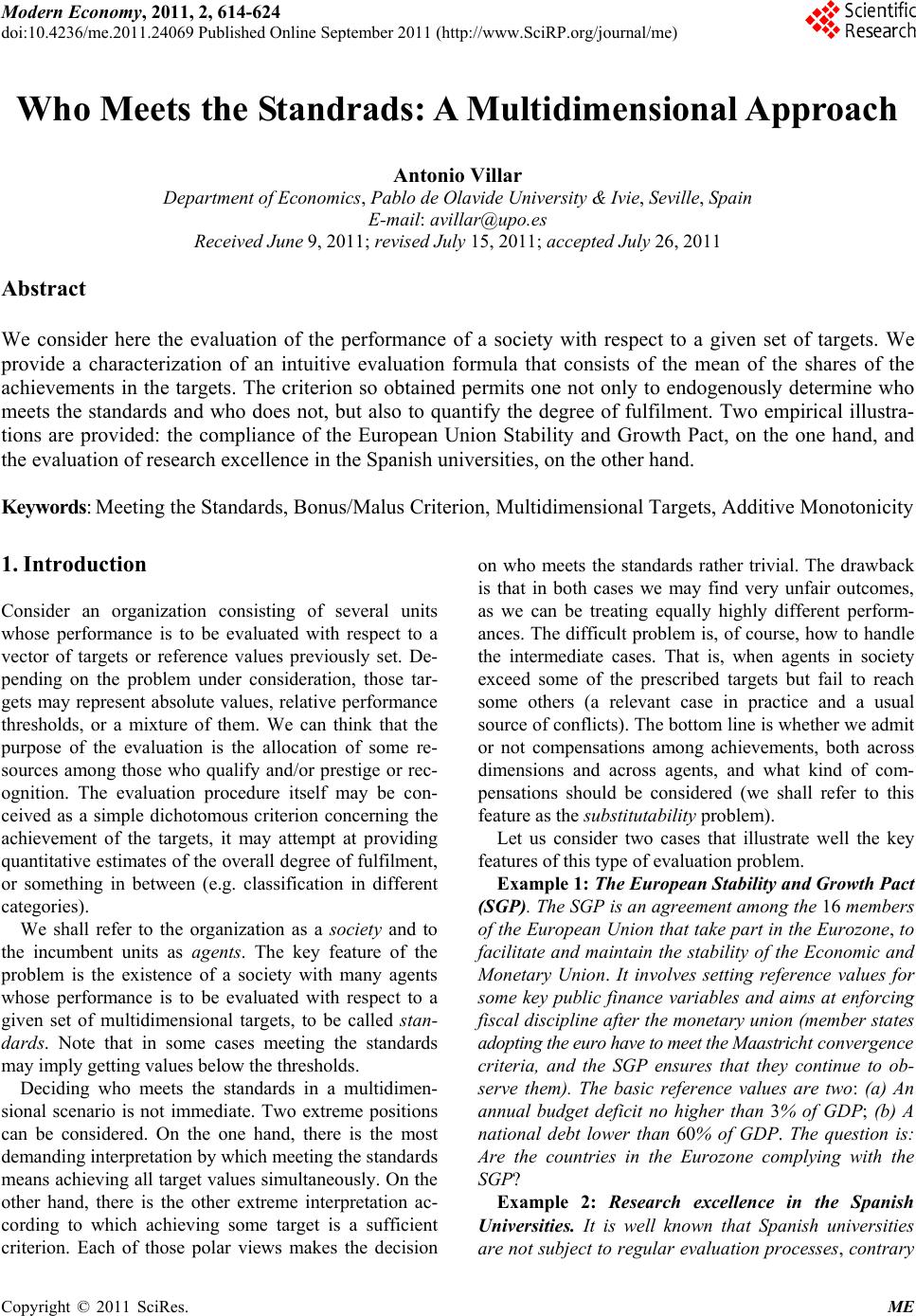 Modern Economy, 2011, 2, 614-624 doi:10.4236/me.2011.24069 Published Online September 2011 (http://www.SciRP.org/journal/me) Copyright © 2011 SciRes. ME Who Meets the Standrads: A Multidimensional Approach Antonio Villar Department of Economics, Pablo de Olavide Uni ve rsi t y & Ivie, Seville, Spain E-mail: avillar@upo.es Received June 9, 2011; revised July 15, 2011; accepted Ju ly 26, 2011 Abstract We consider here the evaluation of the performance of a society with respect to a given set of targets. We provide a characterization of an intuitive evaluation formula that consists of the mean of the shares of the achievements in the targets. The criterion so obtained permits one not only to endogenously determine who meets the standards and who does not, but also to quantify the degree of fulfilment. Two empirical illustra- tions are provided: the compliance of the European Union Stability and Growth Pact, on the one hand, and the evaluation of research excellence in the Spanish universities, on the other hand. Keywords: Meeting the Standards, Bonus/Malus Criterion, Multidimensional Targets, Additive Monotonicity 1. Introduction Consider an organization consisting of several units whose performance is to be evaluated with respect to a vector of targets or reference values previously set. De- pending on the problem under consideration, those tar- gets may represent absolute values, relative performance thresholds, or a mixture of them. We can think that the purpose of the evaluation is the allocation of some re- sources among those who qualify and/or prestige or rec- ognition. The evaluation procedure itself may be con- ceived as a simple dichotomous criterion concerning the achievement of the targets, it may attempt at providing quantitative estimates of the overall degree of fulfilment, or something in between (e.g. classification in different categories). We shall refer to the organization as a society and to the incumbent units as agents. The key feature of the problem is the existence of a society with many agents whose performance is to be evaluated with respect to a given set of multidimensional targets, to be called stan- dards. Note that in some cases meeting the standards may imply getting values below the thresholds. Deciding who meets the standards in a multidimen- sional scenario is not immediate. Two extreme positions can be considered. On the one hand, there is the most demanding interpretation by which meeting the standards means achieving all target values simultaneously. On the other hand, there is the other extreme interpretation ac- cording to which achieving some target is a sufficient criterion. Each of those polar views makes the decision on who meets the standards rather trivial. The drawback is that in both cases we may find very unfair outcomes, as we can be treating equally highly different perform- ances. The difficult problem is, of course, how to handle the intermediate cases. That is, when agents in society exceed some of the prescribed targets but fail to reach some others (a relevant case in practice and a usual source of conflicts). The bottom line is whether we admit or not compensations among achievements, both across dimensions and across agents, and what kind of com- pensations should be considered (we shall refer to this feature as the substitutability problem). Let us consider two cases that illustrate well the key features of this type of evaluation problem. Example 1: The European Stability and Growth Pact (SGP). The SGP is an agreement among the 16 members of the European Union that take part in the Eurozone, to facilitate and maintain the stability of the Economic and Monetary Union. It involves setting reference values for some key public finance variables and aims at enforcing fiscal discipline after the monetary union (member states adopting the euro have to meet the Maastricht convergence criteria, and the SGP ensures that they continue to ob- serve them). The basic reference values are two: (a) An annual budget deficit no higher than 3% of GDP; (b) A national debt lower than 60% of GDP. The question is: Are the countries in the Eurozone complying with the SGP? Example 2: Research excellence in the Spanish Universities. It is well known that Spanish universities are not subject to regular evaluation processes, contrary 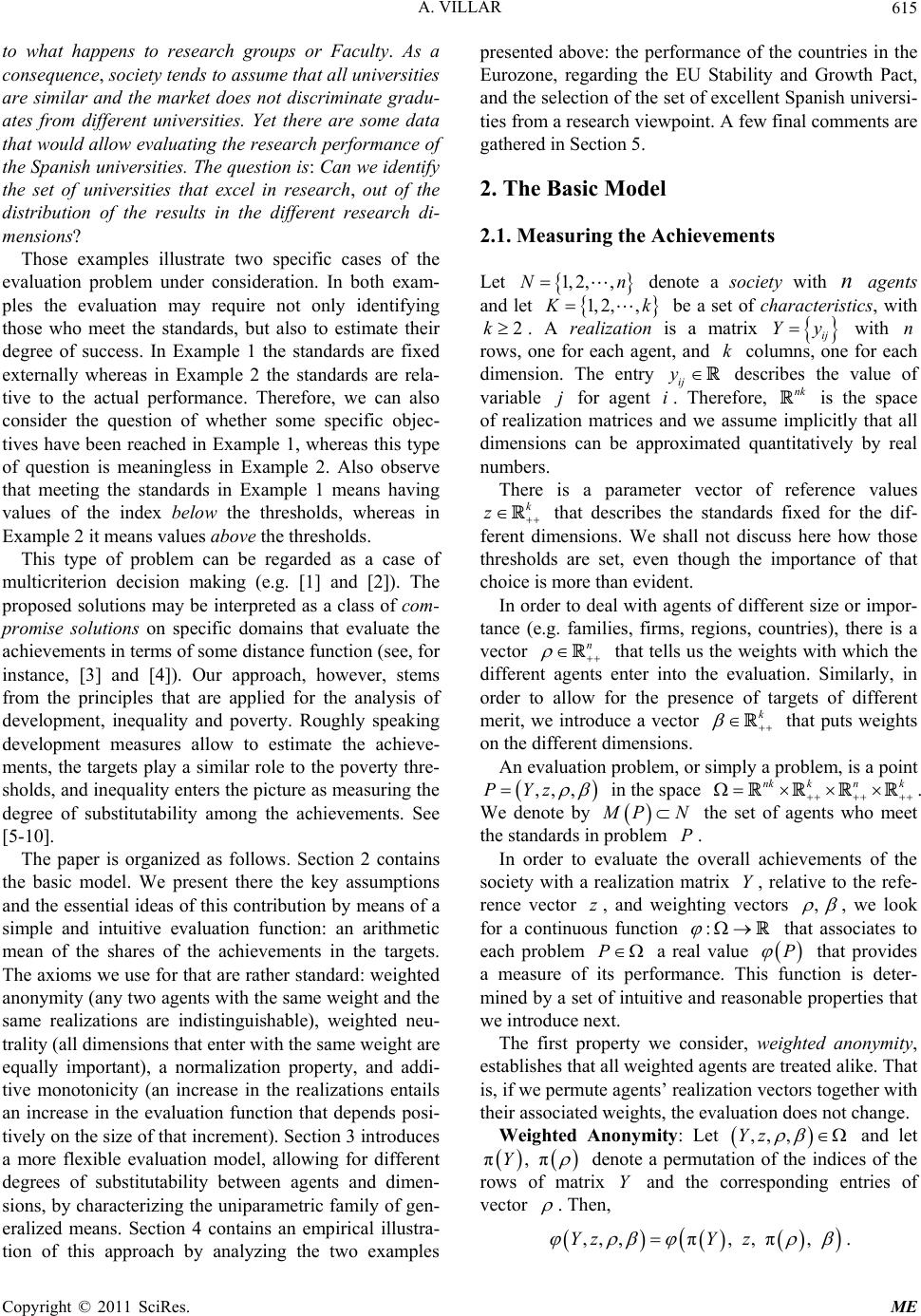 A. VILLAR615 to what happens to research groups or Faculty. As a consequence, society tends to assume that all u niversities are similar and the market does not discriminate gradu- ates from different universities. Yet there are some data that would allow evaluating the research performance of the Spanish universities. The question is: Can we identify the set of universities that excel in research, out of the distribution of the results in the different research di- mensions? Those examples illustrate two specific cases of the evaluation problem under consideration. In both exam- ples the evaluation may require not only identifying those who meet the standards, but also to estimate their degree of success. In Example 1 the standards are fixed externally whereas in Example 2 the standards are rela- tive to the actual performance. Therefore, we can also consider the question of whether some specific objec- tives have been reached in Example 1, whereas this type of question is meaningless in Example 2. Also observe that meeting the standards in Example 1 means having values of the index below the thresholds, whereas in Example 2 it means values above the thresholds. This type of problem can be regarded as a case of multicriterion decision making (e.g. [1] and [2]). The proposed solutions may be interpreted as a class of com- promise solutions on specific domains that evaluate the achievements in terms of some distance function (see, for instance, [3] and [4]). Our approach, however, stems from the principles that are applied for the analysis of development, inequality and poverty. Roughly speaking development measures allow to estimate the achieve- ments, the targets play a similar role to the poverty thre- sholds, and inequality enters the picture as measuring the degree of substitutability among the achievements. See [5-10]. The paper is organized as follows. Section 2 contains the basic model. We present there the key assumptions and the essential ideas of this contribution by means of a simple and intuitive evaluation function: an arithmetic mean of the shares of the achievements in the targets. The axioms we use for that are rather standard: weighted anonymity (any two agents with the same weight and the same realizations are indistinguishable), weighted neu- trality (all dimensions that enter with the same weight are equally important), a normalization property, and addi- tive monotonicity (an increase in the realizations entails an increase in the evaluation function that depends posi- tively on the size of that increment). Section 3 introduces a more flexible evaluation model, allowing for different degrees of substitutability between agents and dimen- sions, by characterizing the uniparametric family of gen- eralized means. Section 4 contains an empirical illustra- tion of this approach by analyzing the two examples presented above: the performance of the countries in the Eurozone, regarding the EU Stability and Growth Pact, and the selection of the set of excellent Spanish universi- ties from a research viewpoint. A few final comments are gathered in Section 5. 2. The Basic Model 2.1. Measuring the Achievements Let 1, 2,,Nn denote a society with agents and let n 1, 2,, k 2 be a set of characteristics, with . A realization is a matrix ij Y with rows, one for each agent, and columns, one for each dimension. The entry ij k yn k y describes the value of variable for agent . Therefore, is the space of realization matrices and we assume implicitly that all dimensions can be approximated quantitatively by real numbers. jink There is a parameter vector of reference values k z that describes the standards fixed for the dif- ferent dimensions. We shall not discuss here how those thresholds are set, even though the importance of that choice is more than evident. In order to deal with agents of different size or impor- tance (e.g. families, firms, regions, countries), there is a vector n that tells us the weights with which the different agents enter into the evaluation. Similarly, in order to allow for the presence of targets of different merit, we introduce a vector that puts weights on the different dimensions. k An evaluation problem, or simply a problem, is a point ,, ,PYz We denote by in the space nk knk . PN the set of agent the standards in problem P. s who meet In order to evaluate the overall achievements of the society with a realization matrix , relative to the refe- rence vector , and weighting vectors Y z, , we look for a continuous function : that associates to each problem P a real value that provides a measure of its performance. This function is deter- mined by a set of intuitive and reasonable properties that we introduce next. P The first property we consider, weighted anonymity, establishes that all weighted agents are treated alike. That is, if we permute agents’ realization vectors together with their associated weights, the evaluation does not change. Weighted Anonymity: Let and let ,, ,Yz π,πY denote a permutation of the indices of the rows of matrix and the corresponding entries of vector Y . Then, ,, ,π,,π,YzY z . Copyright © 2011 SciRes. ME 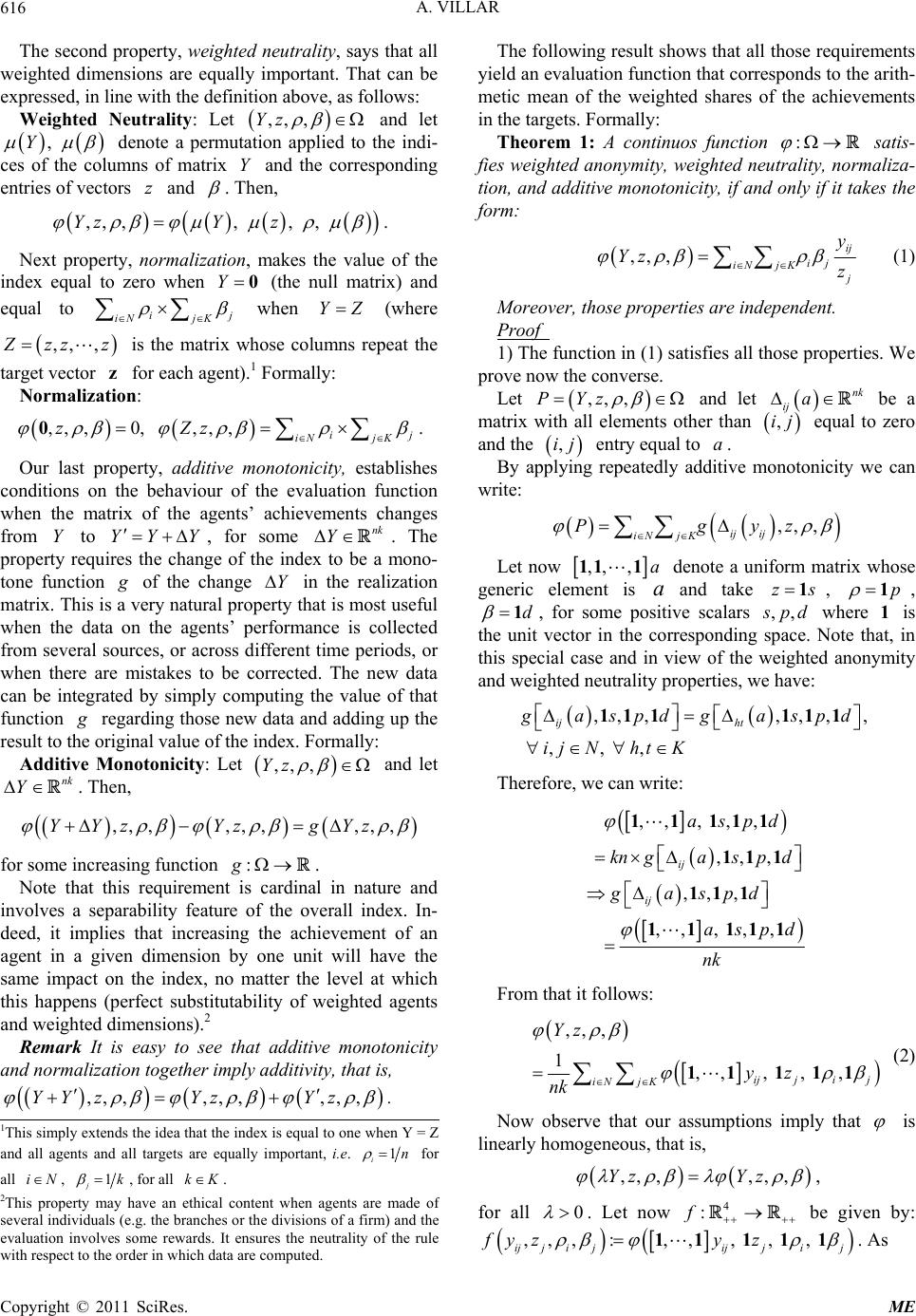 A. VILLAR 616 The second property, weighted neutrality, says that all weighted dimensions are equally important. That can be expressed, in line with the definition above, as follows: Weighted Neutrality: Let and let ,, ,Yz ,Y denote a permutation applied to the indi- ces of the columns of matrix and the corresponding entries of vectors and Y z . Then, ,, ,,,,YzY z . Next property, normalization, makes the value of the index equal to zero when Y 0 (the null matrix) and equal to i iNjK j , when (where YZ ,, zzz z is the matrix whose columns repeat the target vector for each agent).1 Formally: Normalization: ,, ,0,,, ,i iN jK zZz j 0. Our last property, additive monotonicity, establishes conditions on the behaviour of the evaluation function when the matrix of the agents’ achievements changes from to , for some . The property requires the change of the index to be a mono- tone function YYY Y nk Y of the change in the realization matrix. This is a very natural property that is most useful when the data on the agents’ performance is collected from several sources, or across different time periods, or when there are mistakes to be corrected. The new data can be integrated by simply computing the value of that function Y regarding those new data and adding up the result to the original value of the index. Formally: Additive Monotonicity: Let and let . Then, ,, ,Yz nk Y ,, ,,, ,,, ,YYzYz gYz for some increasing function . :g Note that this requirement is cardinal in nature and involves a separability feature of the overall index. In- deed, it implies that increasing the achievement of an agent in a given dimension by one unit will have the same impact on the index, no matter the level at which this happens (perfect substitutability of weighted agents and weighted dimensions).2 Remark It is easy to see that additive monotonicity and normalization together imply additivity, that is, ,, ,,, ,,, ,YY zYzYz The following result shows that all those requirements yield an evaluation function that corresponds to the arith- metic mean of the weighted shares of the achievements in the targets. Formally: Theorem 1: A continuos function : satis- fies weighted anonymity, weighted neutrality, normaliza- tion, and additive monotonicity, if and only if it takes the form: ,, ,ij ij iNjK Yz z (1) Moreover, those properties are independent. Proof 1) The function in (1) satisfies all those properties. We prove now the converse. Let ,, ,PYz and let be a matrix with all elements other than equal to zero and the nk ij a ,ij ,ij entry equal to . a By applying repeatedly additive monotonicity we can write: ,, , ij ij iNjK Pgyz Let now ,,, a11 1a denote a uniform matrix whose generic element is and take , zs1p 1, d 1, for some positive scalars ,, pd where 1 is the unit vector in the corresponding space. Note that, in this special case and in view of the weighted anonymity and weighted neutrality properties, we have: ,, ,,, ,, ,,, ij ht aspdgaspd ij Nht K 11 111 1 Therefore, we can write: ,,,,, ,, , ,, , ,,,,, ij ij aspd kngasp d gaspd aspd nk 11111 11 1 11 1 11111 From that it follows: . ,, , 1,,,,, ijji j iNjK Yz yz nk 11 111 (2) Now observe that our assumptions imply that is linearly homogeneous, that is, ,, ,,, ,Yz Yz , for all 0 . Let now be given by: 4 :f : , ij jijijjij fy,,,z,,, ,yz 111 11. As 1This simply extends the idea that the index is equal to one when Y = Z and all agents and all targets are equally important, i.e. 1 in for all , iN1 jk , for all . kK 2This property may have an ethical content when agents are made o several individuals (e.g. the branches or the divisions of a firm) and the evaluation involves some rewards. It ensures the neutrality of the rule with respect to the order in which data are computed. Copyright © 2011 SciRes. ME 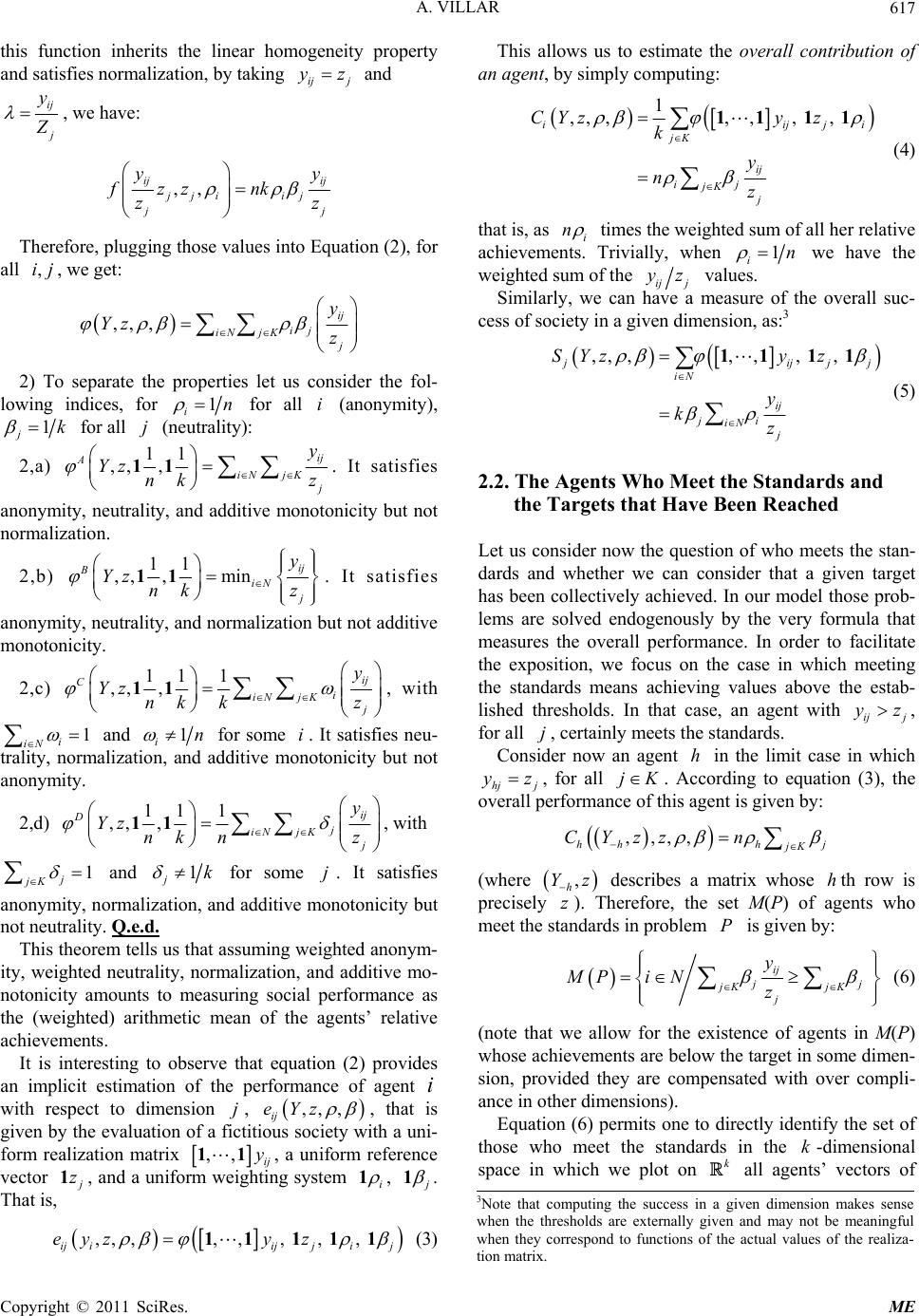 A. VILLAR617 this function inherits the linear homogeneity property and satisfies normalization, by taking and ij j yz ij , we have: ,, ij ij jji ij j yy fzz nk zz Therefore, plugging those values into Equation (2), for all , we get: ,ij ,, ,ij ij iNjK y Yz z 2) To separate the properties let us consider the fol- lowing indices, for 1 in for all (anonymity), i 1 jk for all (neutrality): j 2,a) 11 ,, ,ij A iNjK Yz nk z 11 . It satisfies anonymity, neutrality, and additive monotonicity but not normalization. 2,b) 11 ,, ,minij BiN j y Yz nk z 11 . It satisfies anonymity, neutrality, and normalization but not additive monotonicity. 2,c) 11 1 ,, ,ij Ci iNjK Yz nk kz 11 , with 1 i iN and 1 in for some i. It satisfies neu- trality, normalization, and additive monotonicity but not anonymity. 2,d) 11 1 ,, ,ij Dj iNjK y Yz nk nz 11 , with 1 j jK and 1 jk for some . It satisfies anonymity, normalization, and additive monotonicity but not neutrality. Q.e.d. j This theorem tells us that assuming weighted anonym- ity, weighted neutrality, normalization, and additive mo- notonicity amounts to measuring social performance as the (weighted) arithmetic mean of the agents’ relative achievements. It is interesting to observe that equation (2) provides an implicit estimation of the performance of agent with respect to dimension , i j ,, , ij eYz , that is given by the evaluation of a fictitious society with a uni- form realization matrix ,, ij 11, a uniform reference vector z1, and a uniform weighting system i 1, 1. That is, ,, ,,,,,, ij iijjij eyzy z This allows us to estimate the overall contribution of an agent, by simply computing: 1 ,, ,,,,, ii jK ij ij jK j CYzy z k y nz jji 11 11 (4) that is, as i n times the weighted sum of all her relative achievements. Trivially, when 1 in we have the weighted sum of the ijj yz values. Similarly, we can have a measure of the overall suc- cess of society in a given dimension, as:3 ,, ,,,,, ij jj iN ij ji iN j SYzy z y kz 11 11 (5) 2.2. The Agents Who Meet the Standards and the Targets that Have Been Reached Let us consider now the question of who meets the stan- dards and whether we can consider that a given target has been collectively achieved. In our model those prob- lems are solved endogenously by the very formula that measures the overall performance. In order to facilitate the exposition, we focus on the case in which meeting the standards means achieving values above the estab- lished thresholds. In that case, an agent with , for all , certainly meets the standards. ij j yz j Consider now an agent in the limit case in which hj j h yz , for all jK . According to equation (3), the overall performance of this agent is given by: ,,,, hh h jK CYzznj (where , h Yz z describes a matrix whose th row is precisely ). Therefore, the set M(P) of agents who meet the standards in problem is given by: h P ij jj jK jK j y MPiNz (6) (note that we allow for the existence of agents in M(P) whose achievements are below the target in some dimen- sion, provided they are compensated with over compli- ance in other dimensions). Equation (6) permits one to directly identify the set of those who meet the standards in the -dimensional space in which we plot on all agents’ vectors of k k 11 111 (3) 3Note that computing the success in a given dimension makes sense when the thresholds are externally given and may not be meaningful when they correspond to functions of the actual values of the realiza- tion matrix. Copyright © 2011 SciRes. ME 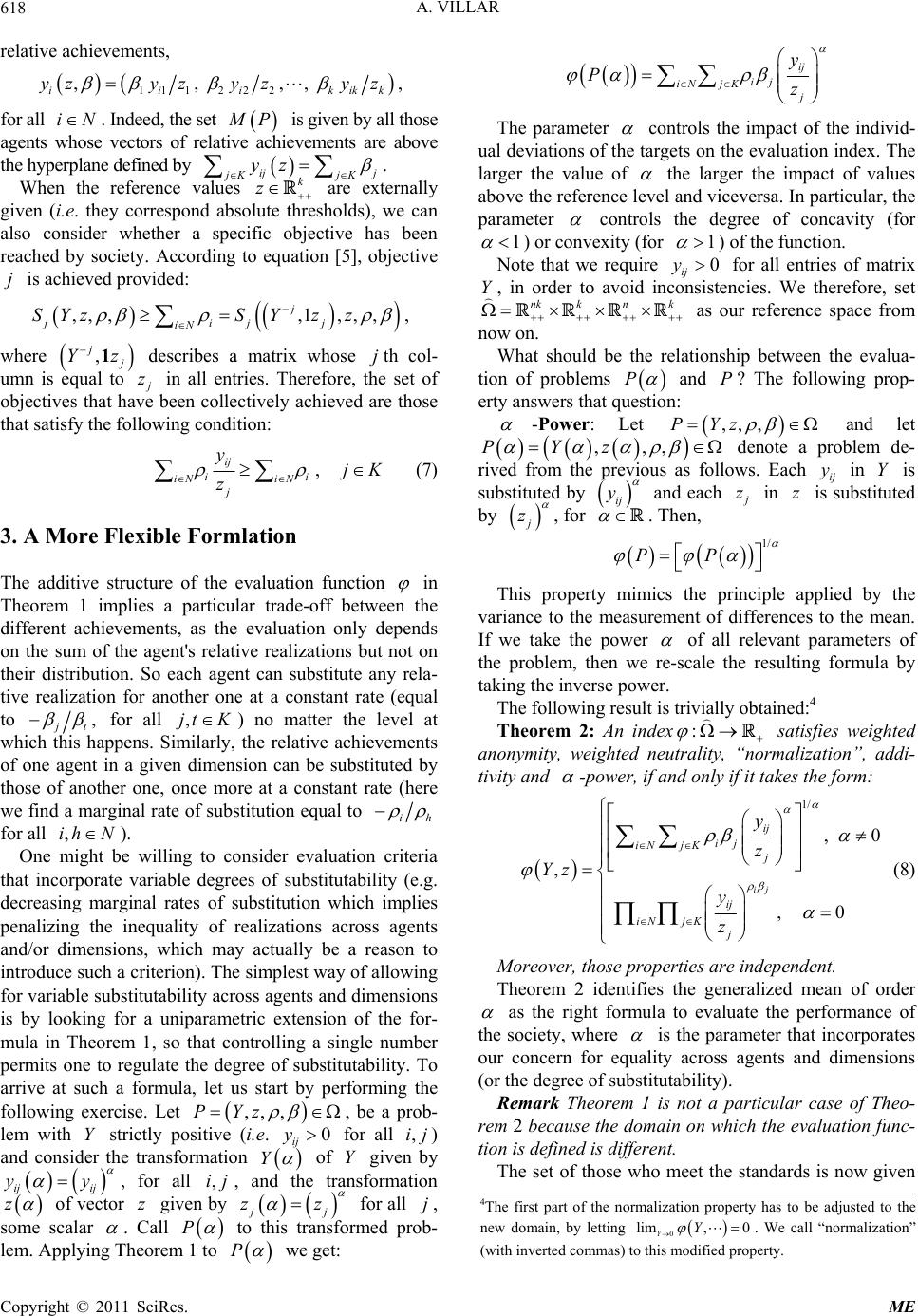 A. VILLAR 618 relative achievements, 1112 22 ,,,, iiikikk zyzyzy z, for all . Indeed, the set iN P ij yz is given by all those agents whose vectors of relative achievements are above the hyperplane defined by j jK jK k . When the reference values are externally given (i.e. they correspond absolute thresholds), we can also consider whether a specific objective has been reached by society. According to equation [5], objective is achieved provided: z j ,, ,,1,, , j jijj iN SYzS Yz z , where , j Yz 1 describes a matrix whose th col- umn is equal to j z in all entries. Therefore, the set of objectives that have been collectively achieved are those that satisfy the following condition: , ij ii iN iN j yjK z (7) 3. A More Flexible Formlation The additive structure of the evaluation function in Theorem 1 implies a particular trade-off between the different achievements, as the evaluation only depends on the sum of the agent's relative realizations but not on their distribution. So each agent can substitute any rela- tive realization for another one at a constant rate (equal to , t for all ) no matter the level at which this happens. Similarly, the relative achievements of one agent in a given dimension can be substituted by those of another one, once more at a constant rate (here we find a marginal rate of substitution equal to ,jtK ih for all ). ,ihN One might be willing to consider evaluation criteria that incorporate variable degrees of substitutability (e.g. decreasing marginal rates of substitution which implies penalizing the inequality of realizations across agents and/or dimensions, which may actually be a reason to introduce such a criterion). The simplest way of allowing for variable substitutability across agents and dimensions is by looking for a uniparametric extension of the for- mula in Theorem 1, so that controlling a single number permits one to regulate the degree of substitutability. To arrive at such a formula, let us start by performing the following exercise. Let ,, ,PYz 0 ij y ij ij iN jKj y Pz The parameter controls the impact of the individ- ual deviations of the targets on the evaluation index. The larger the value of the larger the impact of values above the reference level and viceversa. In particular, the parameter controls the degree of concavity (for 1 ) or convexity (for 1 ) of the function. Note that we require for all entries of matrix , in order to avoid inconsistencies. We therefore, set 0 ij y k Ynk kn as our reference space from now on. What should be the relationship between the evalua- tion of problems P and ? The following prop- erty answers that question: P -Power: Let ,, ,PYz and let , ,,PYz y denote a problem de- rived from the previous as follows. Each ij in is substituted by Y ij y and each z z in is substituted by j z , for . Then, PP 1/ This property mimics the principle applied by the variance to the measurement of differences to the mean. If we take the power of all relevant parameters of the problem, then we re-scale the resulting formula by taking the inverse power. The following result is trivially obtained:4 Theorem 2: An index: satisfies weighted anonymity, weighted neutrality, “normalization”, addi- tivity and -power, if and only if it takes the form: 1/ ,0 , ,0 ij ij ij iN jKj ij iN jK j y z Yz y z (8) Moreover, those properties are independent. Theorem 2 identifies the generalized mean of order as the right formula to evaluate the performance of the society, where is the parameter that incorporates our concern for equality across agents and dimensions (or the degree of substitutability). Remark Theorem 1 is not a particular case of Theo- rem 2 becaus e the domain on which the evaluation func- tion is defined is different. , be a prob- lem with strictly positive (i.e. for all ) and consider the transformation Y,ij Y of Y given by ij yy ij z, for all , and the transformation ,ij of vector given by j The set of those who meet the standards is now given z j zz for all , some scalar j . Call P to this transformed prob- lem. Applying Theorem 1 to P we get: 4The first part of the normalization property has to be adjusted to the new domain, by letting 0 lim, 0 YY . We call “normalization” (with inverted commas) to this modified property. Copyright © 2011 SciRes. ME 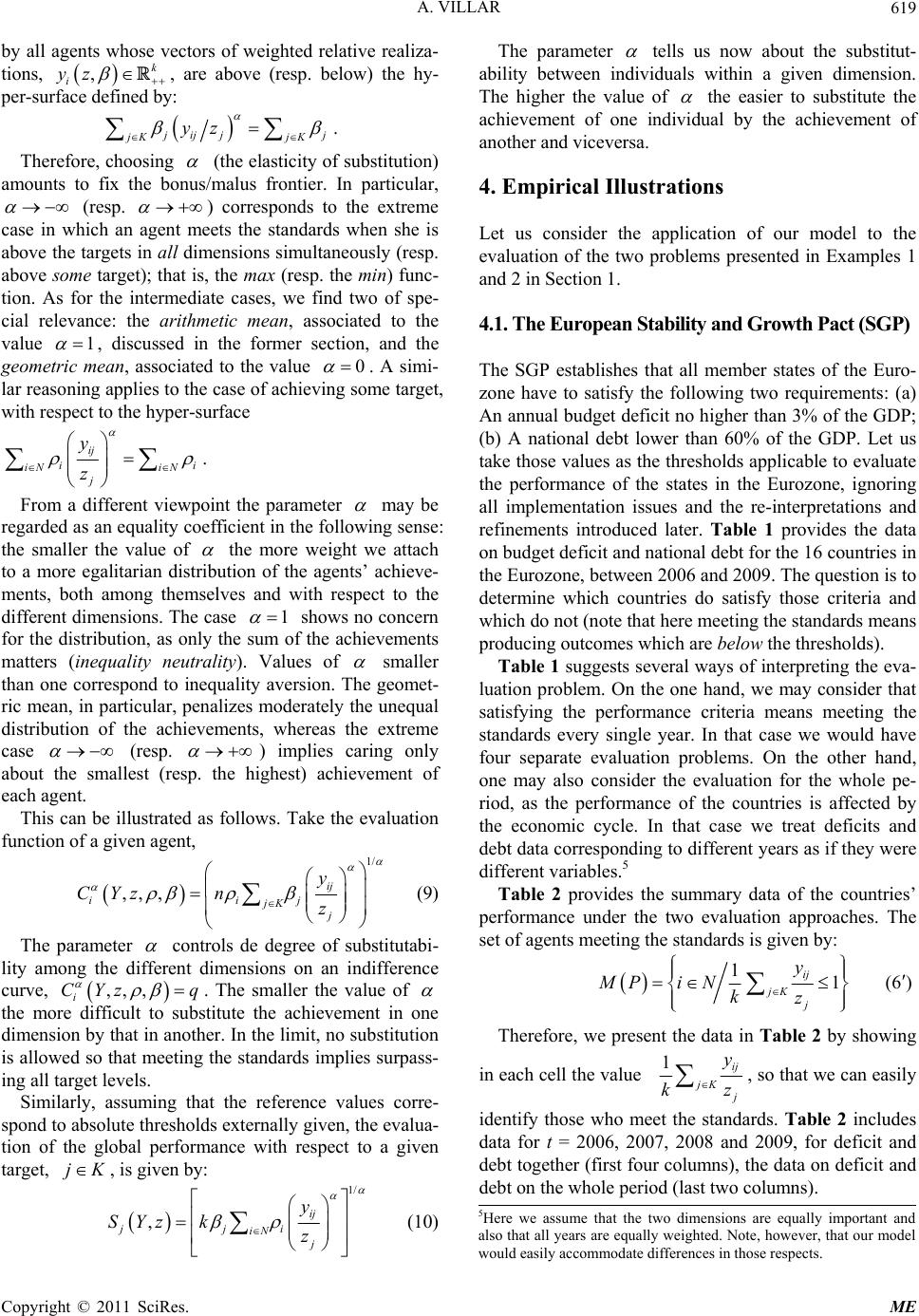 A. VILLAR619 by all agents whose vectors of weighted relative realiza- tions, , are above (resp. below) the hy- per-surface defined by: ,k i yz ij jj jK jK yz . Therefore, choosing (the elasticity of substitution) amounts to fix the bonus/malus frontier. In particular, (resp. ) corresponds to the extreme case in which an agent meets the standards when she is above the targets in all dimensions simultaneously (resp. above some target); that is, the max (resp. the min) func- tion. As for the intermediate cases, we find two of spe- cial relevance: the arithmetic mean, associated to the value 1 , discussed in the former section, and the geometric mean, associated to the value 0 . A simi- lar reasoning applies to the case of achieving some target, with respect to the hyper-surface ij ii iN iN j y z . From a different viewpoint the parameter may be regarded as an equality coefficient in the following sense: the smaller the value of the more weight we attach to a more egalitarian distribution of the agents’ achieve- ments, both among themselves and with respect to the different dimensions. The case 1 shows no concern for the distribution, as only the sum of the achievements matters (inequality neutrality). Values of smaller than one correspond to inequality aversion. The geomet- ric mean, in particular, penalizes moderately the unequal distribution of the achievements, whereas the extreme case (resp. ) implies caring only about the smallest (resp. the highest) achievement of each agent. This can be illustrated as follows. Take the evaluation function of a given agent, 1/ ,, ,ij iij jK j y CYz nz (9) The parameter controls de degree of substitutabi- lity among the different dimensions on an indifference curve, i. The smaller the value of ,,CYz q , the more difficult to substitute the achievement in one dimension by that in another. In the limit, no substitution is allowed so that meeting the standards implies surpass- ing all target levels. Similarly, assuming that the reference values corre- spond to absolute thresholds externally given, the evalua- tion of the global performance with respect to a given target, , is given by: jK 1/ ,ij jji iN j y SYz kz (10) The parameter n value tells us now about the substitut- ability between idividuals within a given d The higher theof imension. the easier to substitute the achieveme i pplication of our model to the resented in Examples 1 s that all member states of the Euro- ent of onndividual by the achievement of another and viceversa. 4. Empirical Illustrations Let us consider the a evaluation of the two problems p and 2 in Section 1. 4.1. The European Stability and Growth Pact (SGP) The SGP establishe zone have to satisfy the following two requirements: (a) An annual budget deficit no higher than 3% of the GDP; (b) A national debt lower than 60% of the GDP. Let us take those values as the thresholds applicable to evaluate the performance of the states in the Eurozone, ignoring all implementation issues and the re-interpretations and refinements introduced later. Table 1 provides the data on budget deficit and national debt for the 16 countries in the Eurozone, between 2006 and 2009. The question is to determine which countries do satisfy those criteria and which do not (note that here meeting the standards means producing outcomes which are below the thresholds). Table 1 suggests several ways of interpreting the eva- luation problem. On the one hand, we may consider that satisfying the performance criteria means meeting the standards every single year. In that case we would have four separate evaluation problems. On the other hand, one may also consider the evaluation for the whole pe- riod, as the performance of the countries is affected by the economic cycle. In that case we treat deficits and debt data corresponding to different years as if they were different variables.5 Table 2 provides the summary data of the countries’ performance under the two evaluation approaches. The set of agents meeting the standards is given by: 11(6) ij jK j y MPi Nkz Therefore, we present the data in Table 2 by showing in each cell the value 1ij jK y kz , so that we can easily id , 2008 and r columns), debt on the whole period (last two columns). entify those who meet the standards. Table 2 includes data for t = 2006, 20072009, for deficit and debt together (first fouthe data on deficit and 5Here we assume that the two dimensions are equally important and also that all years are equally weighted. Note, however, that our model would easily accommodate differences in those respects. Copyright © 2011 SciRes. ME 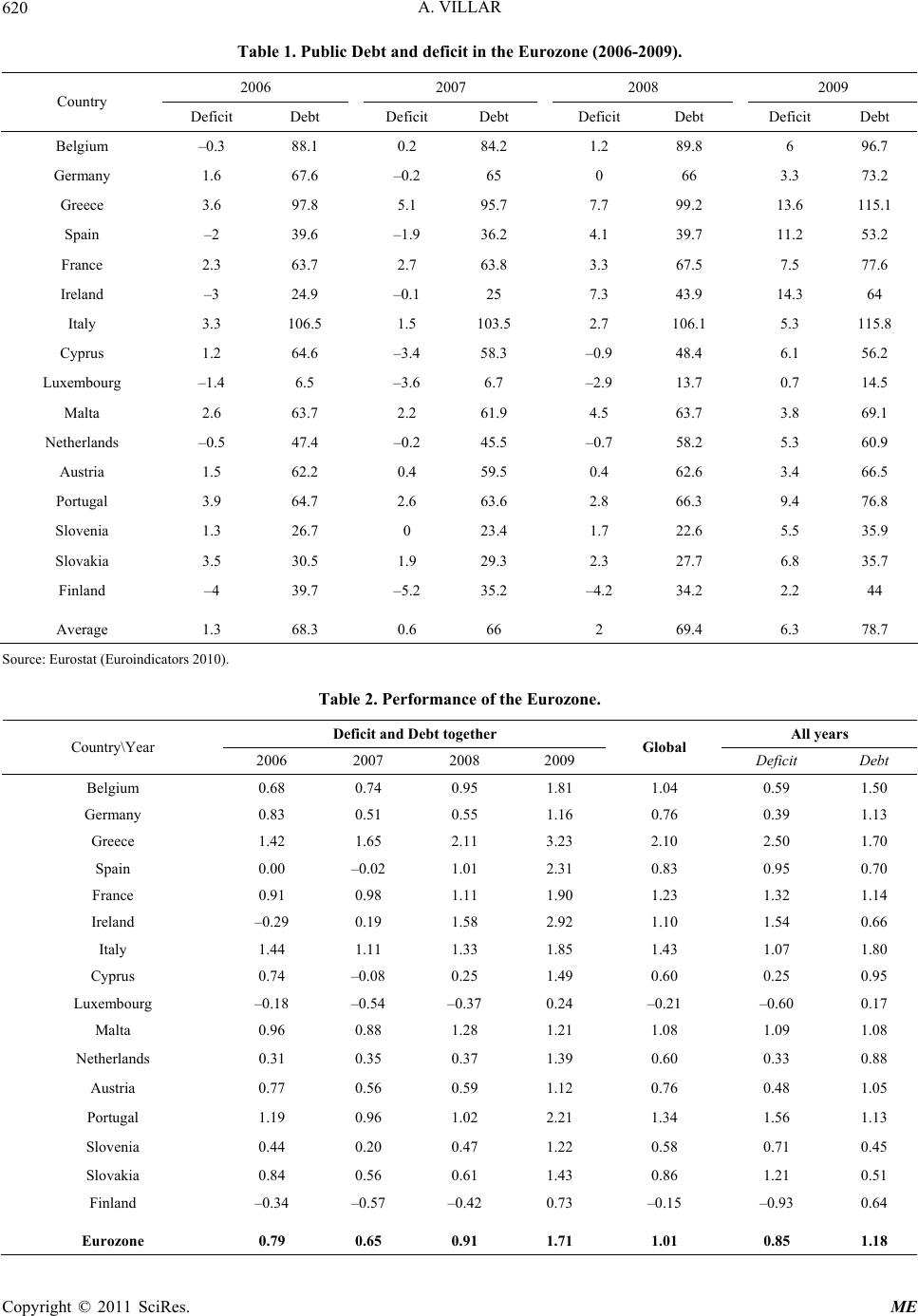 A. VILLAR Copyright © 2011 SciRes. ME 620 cit i 07 2008 2009 Table 1. Public Debt and defin the Eurozone (2006-2009). 2006 20 Country Deficitbt Deficit Debt Debt Deficit Debt Deficit De Belgium –0.3 88.1 0.2 84.2 1.2 89.8 6 96.7 Germany 1.6 67.6 –0.2 65 0 66 3.3 73.2 Greece 3.6 97.8 5.1 95.7 7.7 99.2 1 Luxrg – 3.6115.1 Spain –2 39.6 –1.9 36.2 4.1 39.7 11.2 53.2 France 2.3 63.7 2.7 63.8 3.3 67.5 7.5 77.6 Ireland –3 24.9 –0.1 25 7.3 43.9 14.3 64 Italy 3.3 106.5 1.5 103.5 2.7 106.1 5.3 115.8 Cyprus 1.2 64.6 –3.4 58.3 –0.9 48.4 6.1 56.2 embou–1.4 6.5 –3.6 6.7 –2.9 13.7 0.7 14.5 Malta 2.6 63.7 2.2 61.9 4.5 63.7 3.8 69.1 Netherlands –0.5 47.4 –0.2 45.5 –0.7 58.2 5.3 60.9 Austria 1.5 62.2 0.4 59.5 0.4 62.6 3.4 66.5 Portugal 3.9 64.7 2.6 63.6 2.8 66.3 9.4 76.8 Slovenia 1.3 26.7 0 23.4 1.7 22.6 5.5 35.9 Slovakia 3.5 30.5 1.9 29.3 2.3 27.7 6.8 35.7 Finland –4 39.7 5.2 35.2 –4.2 34.2 2.2 44 Average 1.3 68.3 0.6 66 2 69.4 6.3 78.7 Source: Euroindicators 2 abl2. Pmance e Eurozone Deficit and Debt together All years urostat (E010). Te erforof th. Country\Year 2006 Global Deficit Debt 2007 2008 2009 Belgium 0.68 1.81 1.04 0.59 1.50 0.74 0.95 Germany 0.83 0.51 0.55 1.16 0.76 0.39 1.13 Greece 1.42 1.65 2.11 3.23 2.10 2.50 1.70 Spain 0.00 –0.02 1.01 2.31 0.83 0.95 0.70 France 0. I 91 0.98 1.11 1.90 1.23 1.32 1.14 reland –0.29 0.19 1.58 2.92 1.10 1.54 0.66 Italy 1.44 1.11 1.33 1.85 1.43 1.07 1.80 Cyprus 0.74 –0.08 0.25 1.49 0.60 0.25 0.95 Luxemg –0.–0.–0.–0.–0.bour18 54 37 0.24 21 60 0.17 Malta 0.96 0.88 1.28 1.21 1.08 1.09 1.08 Netherlands 0.31 0.35 0.37 1.39 0.60 0.33 0.88 Austria 0.77 0.56 0.59 1.12 0.76 0.48 1.05 Portugal 1.19 0.96 1.02 2.21 1.34 1.56 1.13 Slovenia 0.44 0.20 0.47 1.22 0.58 0.71 0.45 Slovakia 0.84 0.56 0.61 1.43 0.86 1.21 0.51 Finland –0.34 –0.57 –0.42 0.73 –0.15 –0.93 0.64 Eurozone 0.79 0.65 0.91 1.71 1.01 0.85 1.18  A. VILLAR621 The data show that, accordinriten [6’] there are ocountries that manda y year 2006 and 2Luxem and i g to the crion i nly two between eet the st 009: rds year bourgb F nland. There are 7 more countries that satisfy the crite- ria when considering the whole period: Germany, Spain, Cyprus, Netherlands, Austria, Slovenia and Slovakia. And there are two countries that do not meet the stan- dards in any of the years considered: Greece and Italy. Let us now consider whether the Stability and Growth Pact has been fulfilled collectively along the years ana- lyzed in Tables 1 and 2. To do so we let the weight i of each country be given by its relative GDP. We ob- serve that, taking the two objectives together there is only one year in which the Eurozone did not satisfy the criteria of the SGP (last row of Table 2). Yet the devia- tion was bad enough as to conclude that for the whole Eurozone and the whole period, the pact has not been fulfilled (as .1.01 ). Looking at each objective in- dividually, we observe that the Eurozone has collectively reached the deficit target (nine countries did it individu- ally) but has ftisfy the debt target (even though eight countries met that objective). All together the Eu- rozone has failed to meet the standards, even though nine of the countries have succeeded in doing it. 4.2. Research Excelence in the Spanish Universities ailed to sa ellence data re- orted paper analyzes the performance of ntile 8hin eachory. As weighthe bles we re-scale those in the study that im ollowin We now consider the evaluation of research exc in the Spanish public universities, out of the in [11]. Thisp the Spanish universities and provides an overall ranking using a set of variables whose relative weights are deter- mined by the opinion of researchers obtained by a spe- cific survey. Values are relative to the size of the perma- nent faculty in each university and are normalized so that the top university in each dimension gets a mark of 100.6 Here we take three out of the six variables computed by those authors, as we understand they are the most relevant ones. These variables are: publications (in terms of ISI papers), individual research productivity achieve- ments, IRPA for short,7 and success in getting research funds competitively. In order to define “excellence” we take a relative vector of reference values given by: 175z for ISI publications, 285z for individual productivity achievements, and 350z for research funds. Those values correspond, approximately, to per- ce5 wit categfor thets of varia f ply the g: 10,348 (papers), 20,328 ), and (IRPA 30,324 (funds). Table 3es the data cor- responding to the 48 Spanish univerlyzed. The object of this exercise is to determine the set of universities that are “excellent” from the point of view of their research realizations in 2009.8 If we consider the extreme valu provid sities ana e e the th , that is, thoseities that are abresholds in all dimensions, we find that there are only three universities that meet those standards of univers ov excellence: Universitat Atònoma de Barcelona, Uni- versidad Pablo de Olavide, and Universitat Pompeu Fabra. If we take the case 0 (the geometric mean), we find five addiniversities entering the bonus set: Universidad Autónoma de Madrid, Universitat de Bar- celona, Universidad Carlos III, Universidad Miguel Hernandez, and Universitat Rovira i Virgili. Reducing the level of exigency to 1 tional u (the arithmetic mean) does not add new universitiehat set. Finally, for the other extreme value, s to t (namely, the set of uni- versities that satisfy at least one of those criteria), we find that the set of excellent universities includes five more: Alcalá, Girona, Lleida, Rey Juan Carlos, and Va- lencia. Table 4 gives the data of the 8 universities that meet the excellence standard the geometric and/or the arithmetic mean. The table contains their relative arith- metic mean scores, information about the region in which those universities are placed, and whe- ther they are new (created in the last twenty years, say), modern (c s using reated in the 60’s) or traditional (with a history of hun- dreds of years). Even though discussing those data is not the purpose of this exercise, it is quite noticeable the success of the Catalan universities and the dominance of new and modern universities over the traditional ones. 5. Final Comments We have provided here a criterion to evaluate the per- formance of a society with respect to a collection of tar- gets. This criterion materializes in a simple an intuitive ormula, a mean of order f of the shares of the realiza- h has beized by ents. Thethe mean tions in the targets, whic eans of standard requirem en character order of m is a parameter that determines the substitutability be- tween the achievements and therefore the admissible degree of compensation among the various dimensions and the different agents. From this perspective the model can be regarded as producing endogenously a system of shadow prices that permits one to aggregate the different 6By “permanent Faculty” is understood here those people who are civil servants (funcionarios) within the categories that require a doctoral degree. That should be taken into account in order to interpret the re- sults. 7The “tramos de investigación”, a voluntary individual research evalua- tion carried out every six years by a central agency, that results in a small salary increase. 8The results presented here correspond to the original figures afte rounding them up to integer numbers plus at most two digits. Copyright © 2011 SciRes. ME  A. VILLAR 622 ce Table 3. Research Performanof the Spanish Universities. Universities ISI Articles Research Bonuses Research Funds A Coruña 19.95 65.08 25.44 Alcalá 43.72 85.71 95 80.95 36.65 Alicante 48.31.2 Autólona Autódrid Castilncha Complutense Madrid E 4 L Las Pale G.C. Pablo de Olavide Politécagena Politécnica Cataluña Politécnica Valencia Sa Z Almería 38.82 65.08 23.69 noma Barce91.88 90.47 51.12 noma Ma72.61 95.24 45.79 Barcelona 84.16 80.95 46.18 Burgos 34.99 63.49 28.68 Cádiz 30.16 66.67 19.03 Cantabria 51.53 80.95 34.6 Carlos III 62.01 100 55.53 la-La Ma57.63 77.78 36.6 27.65 77.78 32.13 Córdoba 60.51 77.78 19.53 xtremadura 39.38 77.78 19 Girona 64.91 66.67 60.68 Granada 42.92 77.78 26.94 Huelva 42.66 63.49 22.3 Islas Baleares 40.68 82.54 8.85 Jaén 56.33 66.67 38.46 Jaume I 40.5 79.36 33.06 a Laguna31.28 58.73 14.48 La Rioja 35.56 69.84 25.45 mas d19.82 50.79 17.34 León 29.86 73.01 21.99 Lleida 51.15 69.84 49.94 Málaga 30.27 69.84 20.47 Miguel Hernández 97.28 90.47 49.78 Murcia 41.51 77.78 25.67 Oviedo 37.55 76.19 23.57 80.58 92.06 62.22 País Vasco 19.23 68.25 31.44 nica Cart53.5 69.84 26.67 46.93 74.6 42.55 Politécnica Madrid 30.04 50.79 26.89 62.32 63.49 34.95 Pompeu Fabra 100 87.3 100 Pública Navarra 44.22 74.6 27.28 Rey Juan Carlos 51.48 71.43 52.43 Rovira i Virgili 90.63 84.12 46.01 Salamanca 36.58 79.36 33.77 antiago Compostel49.51 82.54 34.39 Sevilla 36.29 76.19 25.71 UNED 20.88 66.67 20.67 Valencia 55.91 87.3 30.03 Valladolid 31.52 69.84 23.22 Vigo 56.65 66.67 31.11 aragoza 46.4 79.36 29.86 Source: Buela-Cas0). al et al. (201 Copyright © 2011 SciRes. ME 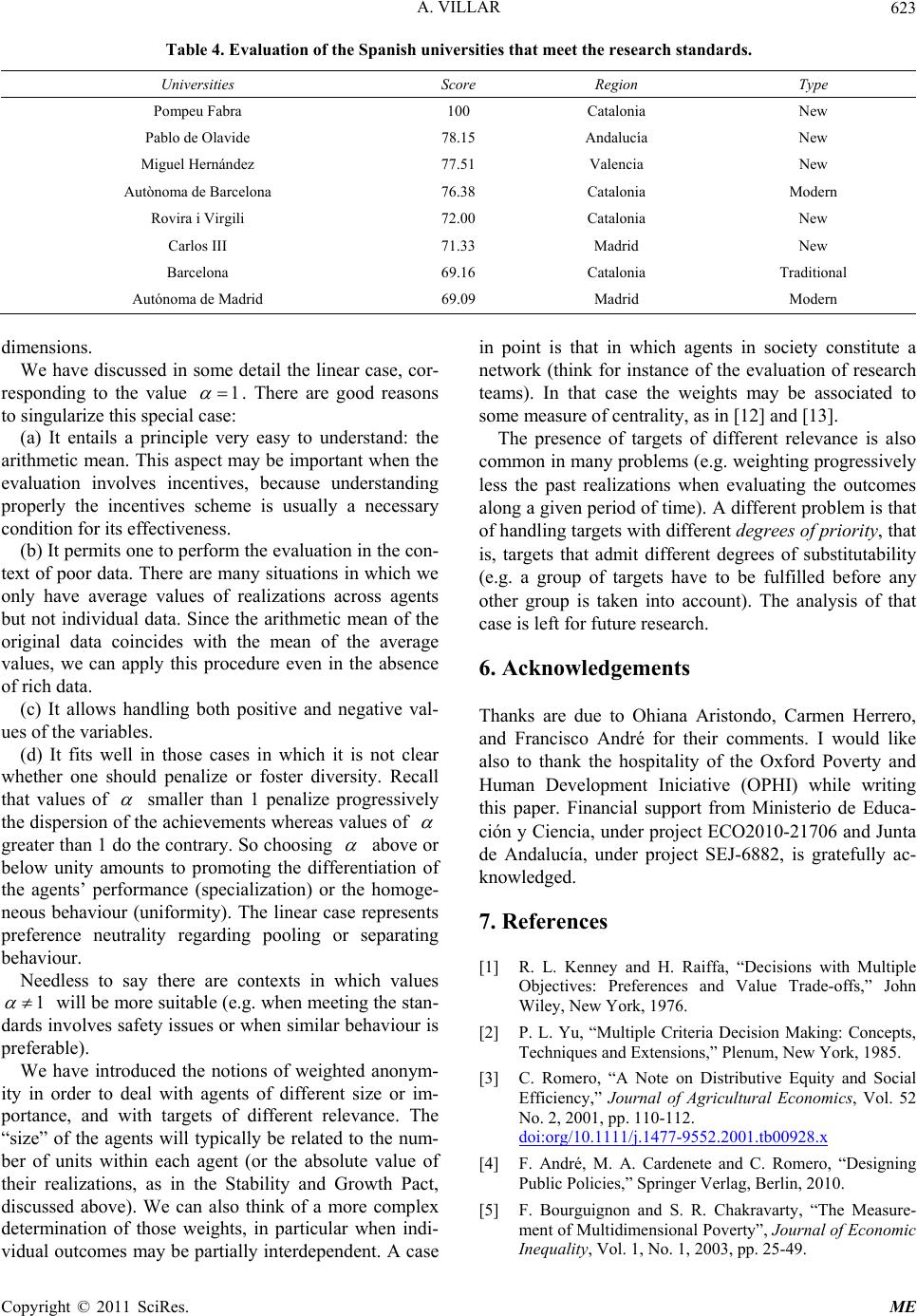 A. VILLAR623 ble 4. Evaluation of tnish universities that me research standards. Region Tahe Spaeet th Universities Score Type Pompeu Fabra 100 Catalonia New Pablo de Olavide 78.15 Andalucía New MiValencia AutònoM T guel Hernández 77.51 76. New nma de Barcelona 38 Catalonia oder Rovira i Virgili 72.00 Catalonia New Carlos III 71.33 Madrid New Barcelona 69. Autónoid 16 Catalonia raditional Mn ma de Madr69.09 Madrid oder dimensions. We have discussedcase, cor- responding to th in some detail the linear e value 1 . There are good reasons singularize this special case: ls a principle very easy to understand: the ar ntive is usually a necessary co he arithmetic mean of the ori hould penalize or foster diversity. Recall th to (a) It entai ithmetic mean. This aspect may be important when the evaluation involves inces, because understanding properly the incentives scheme ndition for its effectiveness. (b) It permits one to perform the evaluation in the con- text of poor data. There are many situations in which we only have average values of realizations across agents but not individual data. Since t ginal data coincides with the mean of the average values, we can apply this procedure even in the absence of rich data. (c) It allows handling both positive and negative val- ues of the variables. (d) It fits well in those cases in which it is not clear whether one s at values of smaller than 1 penalize progressively the dispersion of the achievements whereas values of greater than 1 do the contrary. So choosing above or below unity amounts to promoting the differentiation of the agents’ perfrmance (specialization) or the homoge- neous behaviour (uniformity). The linear case represen preference neutrality regarding pooling or separating behaviour. Needless to say there are contexts in which values 1 o ts will be more suitable (e.g. when meeting the stan- dards involves safety issues or when similar behaviour is preferable). ity in agents will typically be related to the num- be vidual outcomes may be partially interdependent. A n point is thaich agents in society constitute a ork (thinance of the evalesearch ms). In thathe weights may ciated to some measure of centrality, as in [12] and [13]. CO2010-21706 and Junta e Andalucía, under project SEJ-6882, is gratefully ac- ,” Journal of Agricultural Economics, Vol. 52 . 110-112. 1/j.1477-9552.2001.tb00928.x We have introduced the notions of weighted anonym- order to deal with agents of different size or im- portance, and with targets of different relevance. The “size” of the r of units within each agent (or the absolute value of their realizations, as in the Stability and Growth Pact, discussed above). We can also think of a more complex determination of those weights, in particular when indi- The presence of targets of different relevance is also common in many problems (e.g. weighting progressively less the past realizations when evaluating the outcomes along a given period of time). A different problem is that of handling targets with different degrees of priority, that is, targets that admit different degrees of substitutability (e.g. a group of targets have to be fulfilled before any other group is taken into account). The analysis of that case is left for future research. case it in wh netwk for instuation of r teat case be asso 6. Acknowledgements Thanks are due to Ohiana Aristondo, Carmen Herrero, and Francisco André for their comments. I would like also to thank the hospitality of the Oxford Poverty and Human Development Iniciative (OPHI) while writing this paper. Financial support from Ministerio de Educa- ción y Ciencia, under project E d knowledged. 7. References [1] R. L. Kenney and H. Raiffa, “Decisions with Multiple Objectives: Preferences and Value Trade-offs,” John Wiley, New York, 1976. [2] P. L. Yu, “Multiple Criteria Decision Making: Concepts, Techniques and Extensions,” Plenum, New York, 1985. [3] C. Romero, “A Note on Distributive Equity and Social Efficiency No. 2, 2001, pp doi:org/10.111 . Chakravarty, “The Measure- [4] F. André, M. A. Cardenete and C. Romero, “Designing Public Policies,” Springer Verlag, Berlin, 2010. [5] F. Bourguignon and S. R ment of Multidimensional Poverty”, Journal of Economic Inequality, Vol. 1, No. 1, 2003, pp. 25-49. Copyright © 2011 SciRes. ME  A. VILLAR 624 doi:org/10.1023/A:1023913831342 [6] S. R. Chakravarty, “A Generalized Human Development Index”, Review of Development Economics, Vol. 7, No. 1, 2003, pp. 99-114. doi:org/10.1111/1467-9361.00178 ultidimen- e [7] C. Herrero, R. Martinez and A. Villar, “M sional Social Evaluation. An Application to the Measure- ment of Human Development”, The Review of Incom and Wealth, Vol. 56, No. 3, 2010, pp. 483-497. doi:org/10.1111/j.1475-4991.2009.00375.x [8] S. Seth, “A Class of Sensitive Multidimen Indices,” Vanderbilt University, Nashv sional Welfare ille, Mimeo 2010. [9] K. Tsui, “Multidimensional Poverty Indices,” Social Choice and Welfare, Vol. 19, No. 1, 2002, pp. 69-93. doi:org/10.1007/s355-002-8326-3 [10] A. Villar, “A New Approach to the Measurement of Mul- tidimensional Poverty,” Pablo de Olavide University a, . (2010), Ranking de l and Y. Zenou, “Who's Working Paper, Seville, 2010. [11] G. Buela-Casal, M. P. Bermúdez and J. C. Sierr “Quevedo-Blasco, R. & Castro, A 2009 en Investigación de las Universidades Públicas Españolas,” Psicothema, Vol. 22, pp. 171-179. [12] C. Ballester, A. Calvó-Armengo Who in Networks. Wanted: the Key Player,” Economet- rica, Vol. 74, No. 5, 2006, pp. 1403-1417. doi:org/10.1111/j.1468-0262.2006.00709.x [13] B. Ruhnau, “Eigenvector-centrality: A Node Centrality?” Social Networks, Vol. 22, No. 4, 2000, pp. 357-365. doi:org/10.1016/S0378-8733(00)00031-9 Copyright © 2011 SciRes. ME
|